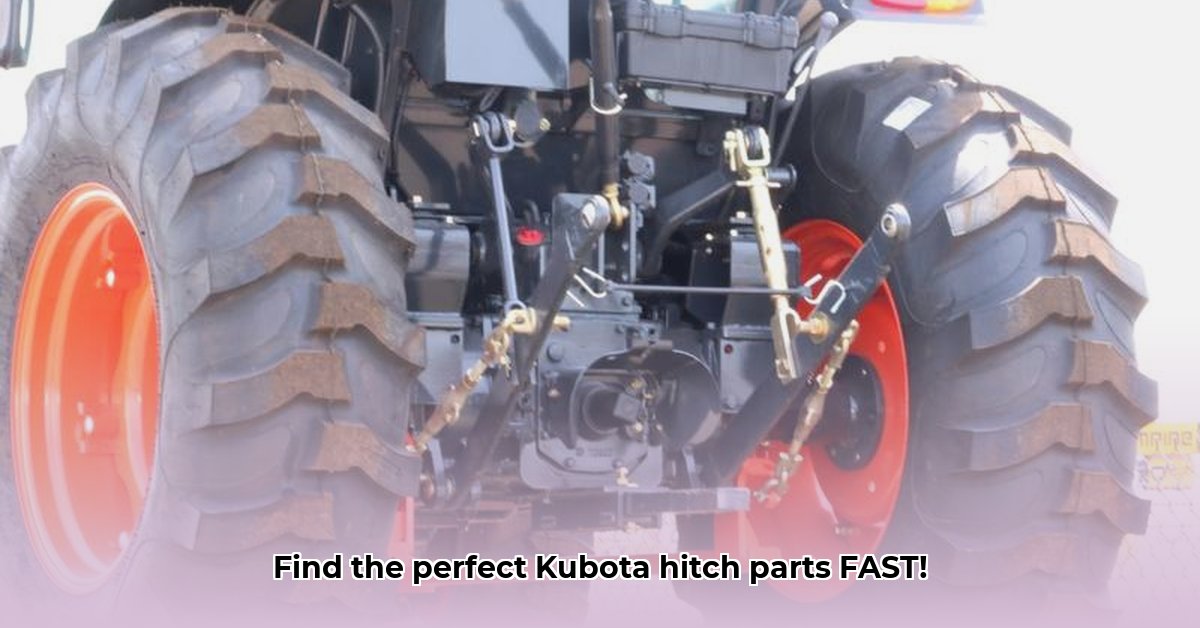
Understanding Your Kubota's Three-Point Hitch System
Kubota tractors are renowned for their robust three-point hitch systems, essential for connecting and operating a wide range of implements vital for efficient and sustainable agriculture. This system, a marvel of engineering, uses three connection points – two lower links and one top link – to create a stable triangle that allows for precise control and adjustment of attached implements such as plows, mowers, and tillers. Understanding this system is key to maximizing your Kubota's versatility and efficiency. Did you know that proper three-point hitch maintenance can increase your operational uptime by as much as 15%?
Types of Kubota Three-Point Hitch Parts: A Detailed Overview
Several key components make up the three-point hitch system:
Lower Links: These are the primary connection points between your tractor and the implement. They bear the weight of the implement and transmit power from the tractor's PTO (Power Take-Off – (the engine-driven shaft that powers the equipment)). Lower links are often adjustable in length to accommodate various implement sizes.
Top Link: This provides the third point of contact, crucial for controlling implement tilt and preventing excessive bouncing or swaying. Adjusting the top link is essential for optimal performance, particularly on uneven terrain.
Sway Bars: These lateral stabilizers reduce side-to-side movement, significantly improving stability and preventing damage to both the implement and the tractor. They are essential for safe and efficient operation, particularly when working with heavier implements or on slopes.
Stabilizers: These enhance stability further, especially beneficial when dealing with larger or heavier implements. Stabilizers minimize bouncing and drifting, resulting in improved control and precision.
Hydraulic Cylinders: These powerful components raise and lower the implements, controlled via the tractor's hydraulic system. Regular maintenance and inspection of hydraulic cylinders are critical for ensuring smooth operation and preventing leaks or malfunctions.
Choosing the Right Parts for Your Kubota Tractor
Selecting the correct parts is paramount for safe and efficient operation. Always consult your Kubota owner's manual for specific part numbers and compatibility information. Consider factors such as:
Kubota Model: Different Kubota tractor models may have different three-point hitch specifications. Ensuring compatibility is crucial to avoid costly mistakes.
Implement Type: The type of implement you're using (e.g., plow, mower, tiller) will influence the required strength and capacity of the hitch components. Heavier implements demand more robust parts.
Intended Use: The intensity and nature of your work will impact the durability and longevity needed in your parts. Frequent use in challenging terrain calls for more resilient components.
Installing and Maintaining Your Three-Point Hitch: A Step-by-Step Guide
Proper installation and regular maintenance are critical for long-term performance and safety. Always follow these steps:
Safety First: Before starting any work, ensure the PTO is disengaged, the parking brake is engaged, and the tractor is turned off.
Secure Connections: Carefully attach the lower and top links to both the tractor and the implement, ensuring all pins are securely fastened.
Adjustments: Fine-tune the top link to achieve the desired implement angle and stability. Slight adjustments can significantly impact performance.
Regular Inspections: Periodically inspect all components for wear, tear, or damage. Address any issues promptly to prevent more significant problems.
Lubrication: Regularly lubricate moving parts of the hitch assembly using the recommended grease type specified in your owner's manual. This minimizes friction and extends component life.
Replace Worn Parts: Replace worn or damaged parts immediately. Ignoring this can lead to malfunctions and potential safety hazards. "Ignoring minor issues can escalate into major breakdowns," states Dr. Emily Carter, Agricultural Engineering Professor at Purdue University.
Finding Reliable Suppliers: Ensuring Quality Parts
Sourcing quality parts is vital. Your options include:
Kubota Dealers: They offer genuine OEM (Original Equipment Manufacturer) parts guaranteeing fit and performance, often with warranties. Purchasing from authorized dealers ensures quality control.
Online Retailers: These offer convenience and potentially lower prices, but thorough research and checking reviews are crucial to ensure part authenticity and seller reliability. It’s wise to compare prices and check customer reviews before committing to a purchase.
Local Agricultural Suppliers: These provide opportunities for in-person inspection and expert advice, which can be invaluable, particularly for those new to Kubota tractors.
Conclusion: Maximizing Performance Through Proper Maintenance
Investing in high-quality Kubota three-point hitch parts and implementing a consistent maintenance schedule are essential for optimal performance, safety, and the longevity of your equipment. Remember, regular inspection and timely replacement of worn-out parts will directly translate to increased efficiency, reduced downtime, and a significant return on your investments. Preventative maintenance is key to maximizing the operational lifespan of your Kubota tractor.